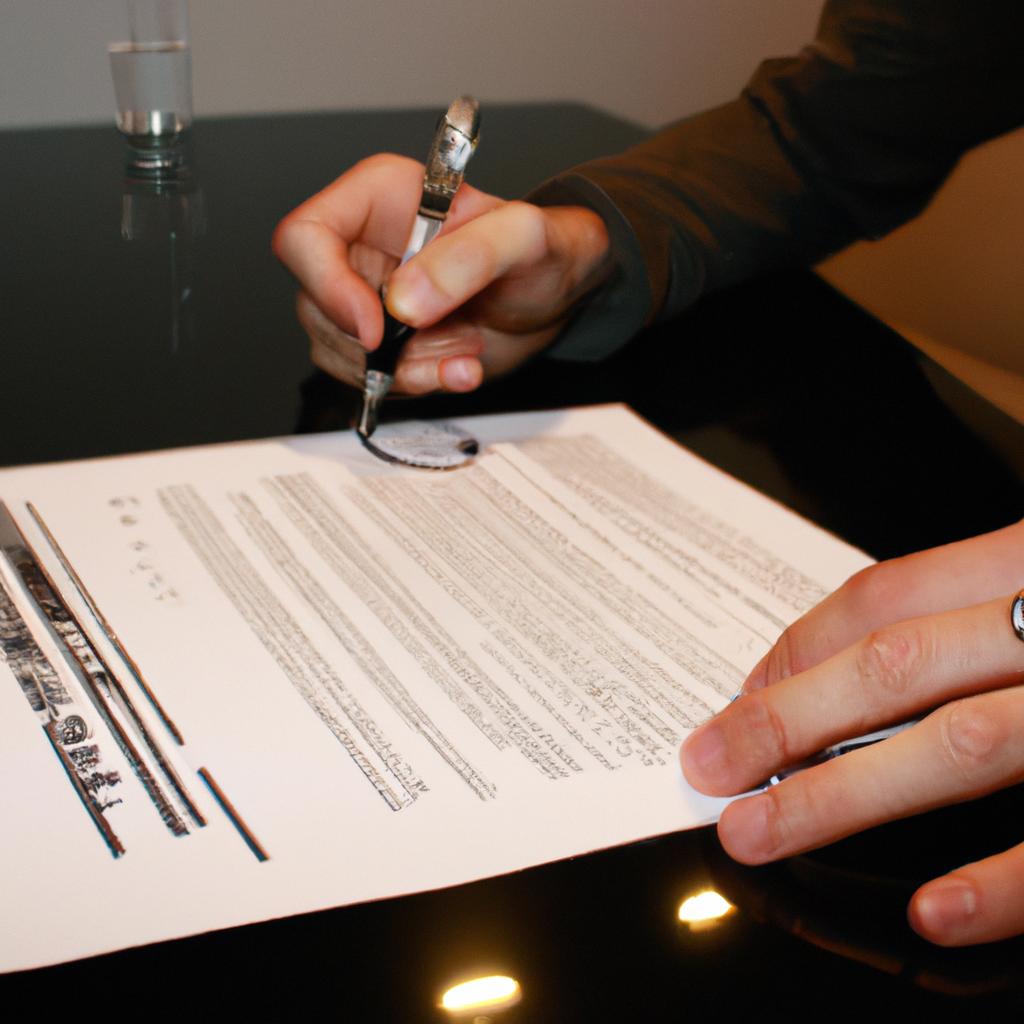The music industry is a complex and ever-evolving landscape, with the issue of publishing rights serving as a crucial aspect that musicians and creators must navigate. Understanding the intricacies of music licensing is essential to protecting one’s work and ensuring fair compensation for their artistic endeavors. In this article, we will delve into the world of music publishing rights, exploring its various aspects and shedding light on the importance of having a comprehensive understanding of this field.
Imagine a scenario where an independent musician creates a captivating song, pouring their heart and soul into every lyric and melody. They release it online, hoping for recognition and success. However, unbeknownst to them, another artist samples their track without permission or proper licensing. The unauthorized use results in substantial financial gains for the infringing party while leaving the original creator struggling to make ends meet. This hypothetical case highlights the significance of understanding music licensing and how it can protect artists from such unfortunate circumstances. By delving into the realm of publishing rights with Jose Carlos Matos Music, we aim to provide individuals within the music industry with valuable insights and practical knowledge necessary to safeguard their creative works effectively.
Understanding Publishing Rights
Imagine you are a talented musician who has just composed and recorded an incredible song. You believe it has the potential to become a hit, but what steps should you take to protect your work and ensure that you receive appropriate recognition and compensation? This is where understanding publishing rights becomes crucial in the music industry.
Publishing rights refer to the legal ownership of musical compositions. These rights grant individuals or entities the exclusive authority to reproduce, distribute, perform, and license these compositions for public use. For example, let’s consider a hypothetical scenario: Sarah writes a beautiful melody on her piano and records it as a solo composition. She wants this piece to be performed by other musicians and used in advertisements or films. To achieve this, she needs to understand how publishing rights work.
To delve deeper into this topic, here are some important aspects of publishing rights:
- Ownership: The first thing to determine is who owns the publishing rights. In most cases, when a songwriter creates a composition independently, they automatically own both the copyright (the right to make copies) and the publishing rights.
- Licensing: Once ownership is established, licensing plays a significant role in monetizing musical compositions. By granting licenses, composers can authorize others – such as record labels, streaming platforms, or filmmakers – to utilize their works in exchange for royalties or fees.
- Royalties: When someone uses a copyrighted composition with permission from the owner (through licensing), they typically pay royalties. Royalties are financial compensations that reflect usage frequency and reach. They serve as income streams for composers.
- Collective Management Organizations (CMOs): CMOs play an essential role in monitoring and collecting royalties on behalf of composers. These organizations track performances of songs across various mediums like radio broadcasts or live concerts and collect payments accordingly.
By understanding these key concepts surrounding publishing rights in music, artists like Sarah can navigate through the complex landscape of intellectual property protection while ensuring fair compensation for their creative endeavors.
Moving forward, let’s explore the different types of music licenses and how they enable composers to share their work with the world.
Different Types of Music Licenses
In the previous section, we explored the intricacies of publishing rights in music licensing. Now, let’s delve deeper into the different types of music licenses that exist and how they function within the industry.
Consider this hypothetical scenario: a rising independent artist named Sarah has just released her debut album. She wants to ensure that she retains control over her compositions while also maximizing her earning potential through licensing opportunities. To navigate this complex landscape successfully, Sarah needs to understand various types of music licenses available to her.
-
Mechanical License:
- This license grants permission for reproducing and distributing musical compositions.
- It is typically required when an artist or record label wishes to release a cover version of a song originally written by someone else.
- The mechanical royalty rate varies based on factors such as format (CD, digital download), distribution size, and territory.
-
Synchronization License:
- This license allows for the use of music alongside visual media like films, TV shows, advertisements, or video games.
- Artists can negotiate synchronization fees with production companies depending on factors like prominence within the project and exclusivity terms.
- In some cases, artists may also receive performance royalties if their synchronized work is broadcasted publicly.
-
Performance License:
- This license permits the public performance of copyrighted music.
- Performing Rights Organizations (PROs) collect and distribute performance royalties to songwriters and publishers whenever their works are performed live or played on radio stations, streaming platforms, or in venues.
- PROs monitor usage data from broadcasters and establishments through systems like Music Monitoring Services (MMS).
-
Print License:
- A print license authorizes sheet music publication for commercial purposes.
- Composers often grant these licenses when their compositions have significant demand among musicians who wish to perform them.
By understanding these different types of music licenses, artists like Sarah can make informed decisions about their compositions and ensure proper compensation for their work.
The Role of Performing Rights Organizations
Understanding the various types of music licenses helps artists and creators navigate the complex world of music licensing. Now, let’s delve into the crucial role that performing rights organizations (PROs) play in protecting artists’ interests and ensuring fair compensation for their work.
The Role of Performing Rights Organizations:
One example highlighting the importance of PROs can be seen through a hypothetical scenario involving an independent artist named Sarah. Sarah recently released her debut album, which gained significant popularity on streaming platforms. As her songs started receiving airplay on various radio stations, she realized it was time to explore music licensing options.
With this need in mind, Sarah decided to join a PRO. These organizations act as intermediaries between artists and entities that want to use their music commercially. They handle licensing agreements, collect royalties from different sources such as broadcast radio, live performances, digital streaming services, and distribute those earnings back to the musicians they represent.
To better understand how PROs operate within the realm of music licensing, consider the following key points:
- PROs offer blanket licenses that allow venues like restaurants or retail stores to play any song from their catalogs without needing individual permissions.
- They conduct extensive monitoring efforts to track public performances and ensure proper royalty payments are made.
- PROs negotiate license fees based on factors such as audience size, frequency of usage, and commercial nature.
- Artists receive performance royalties when their compositions are publicly performed or broadcasted.
| Pros | Benefits | Challenges |
|---|---|---|
| Ease | Streamlined | Complex |
| administration | legal procedures | |
| Fair | Ensures fair | Establishing |
| compensation for | global | |
| artists | relationships | |
| Supportive | Offers resources | Dependence on |
| and guidance to | PROs for | |
| emerging artists | representation |
In conclusion, performing rights organizations play a vital role in the music licensing landscape by protecting artists’ interests and ensuring they receive fair compensation. By joining a PRO, artists can benefit from streamlined administration processes, enjoy fair royalty payments, and access valuable resources and support. Now let’s explore the essential steps involved in obtaining music licenses.
To obtain music licenses effectively, it is important to follow specific guidelines that ensure compliance with copyright regulations and allow for seamless integration of licensed music into various mediums.
Steps to Obtain Music Licenses
In the world of music licensing, performing rights organizations (PROs) play a crucial role in ensuring that songwriters and composers receive fair compensation for their work. These organizations act as intermediaries between the creators of musical works and those who wish to use them for public performances or broadcasting. To better understand the significance of PROs, let’s consider an example:
Imagine a small café owner named Sarah who wants to create a cozy ambiance by playing background music in her establishment. She selects various songs from different artists and starts playing them regularly. However, Sarah soon realizes that she needs permission to publicly perform these songs and compensate the creators appropriately.
This is where PROs step in. They offer licenses that allow businesses like cafes, radio stations, restaurants, and even concert venues to legally play copyrighted music. By obtaining a license from a PRO, Sarah can ensure that the songwriters and composers behind each track played at her café receive proper royalties.
To shed light on how performing rights organizations operate further, here are some key points:
- PROs collect fees from establishments or entities that want to use copyrighted music.
- The collected fees are then distributed among the registered members based on factors such as the frequency of performance and popularity of their works.
- Different PROs may have affiliations with international counterparts to manage global royalty collections effectively.
- It is important for businesses using copyrighted music to be aware of which specific PRO represents each song they intend to use since it could differ depending on the songwriter/composer involved.
Considering all this information, it becomes evident why performing rights organizations hold significant importance within the realm of music licensing.
| Benefits of Working with PROs | Challenges Faced without PROs | Impact on Artists |
|---|---|---|
| Access to a vast catalog of music | Legal consequences for infringement | Fair compensation |
| Simplified licensing process | Difficulty in tracking song ownership | Exposure to wider audiences |
| Assurance of legal compliance | Lack of accurate royalty distribution | Protection against piracy |
Moving forward, we will delve into the steps involved in obtaining music licenses, which will provide a clearer picture of how individuals and businesses can navigate this complex landscape successfully. Understanding these steps is essential for anyone seeking to use copyrighted music while respecting the rights of its creators.
Transitioning smoothly from discussing the role of performing rights organizations, let us now explore some common challenges faced by individuals and businesses when it comes to music licensing.
Common Challenges in Music Licensing
Section: Common Challenges in Music Licensing
Transitioning from the steps of obtaining music licenses, it is important to understand that navigating through the world of music licensing can be a complex and challenging endeavor. Artists, composers, and other stakeholders encounter various obstacles while seeking proper authorization for their musical works. To shed light on these challenges, let’s consider an example:
Imagine a talented independent musician named Sarah who wants to license her original song for use in a television commercial. She has gone through the necessary steps to obtain a music license but now faces common hurdles that many artists experience during this process.
One major challenge faced by musicians like Sarah is determining the appropriate licensing fees for their work. Negotiating fair compensation can be daunting due to factors such as budget limitations of potential licensees or varying industry standards. Additionally, understanding how different platforms utilize licensed music—whether it’s for advertisements, streaming services, or video games—is crucial in order to negotiate suitable rates.
Another obstacle arises when trying to locate and contact the right individuals for licensing purposes. The music industry involves numerous entities including record labels, publishers, performing rights organizations (PROs), and sync agents. Identifying the correct point of contact within these organizations can often prove difficult, resulting in time wasted searching for key decision-makers.
Furthermore, copyright infringement issues pose significant challenges in music licensing. Unauthorized usage or unlicensed sampling of copyrighted material remains prevalent despite efforts made towards educating creators about legal requirements. This issue not only affects artists financially but also undermines the integrity and protection of intellectual property rights within the industry.
To illustrate some emotional responses related to these challenges:
- Frustration: Dealing with complicated negotiations and unclear industry standards can leave artists feeling frustrated.
- Confusion: The difficulty in locating the right contacts amidst a vast network of professionals often leads musicians into confusion.
- Fear: Copyright infringement presents a constant threat to artists’ livelihoods, instilling fear regarding the protection of their work.
- Disappointment: Unfair compensation or unauthorized usage can leave artists feeling disappointed and undervalued.
To summarize the common challenges faced in music licensing, consider the following table:
| Challenges in Music Licensing |
|---|
| Determining appropriate licensing fees |
| Locating and contacting relevant individuals for licensing |
| Copyright infringement issues |
As musicians like Sarah navigate these hurdles, it is crucial to remain persistent and seek guidance from experts such as Jose Carlos Matos Music. By understanding and addressing these challenges head-on, artists increase their chances of successfully monetizing their creative efforts through legitimate music licensing channels.
Transitioning into the next section about maximizing revenue from music licensing, it is essential to explore strategies that help artists overcome these obstacles while capitalizing on opportunities within the industry.
Maximizing Revenue from Music Licensing
Maximizing Revenue from Music Licensing
In the previous section, we explored some of the common challenges faced in music licensing. Now, let us delve into strategies that can help artists and composers maximize their revenue through effective music licensing.
To illustrate these strategies, let’s consider a hypothetical case study involving an independent musician named Sarah. Sarah has just released her debut album and wants to ensure she maximizes her income potential by leveraging music licensing opportunities.
-
Diversify Your Catalog: One key strategy for maximizing revenue is to have a diverse catalog of songs available for licensing. This allows you to cater to different genres, moods, and themes sought by various media platforms. By having a wide range of songs in your repertoire, you increase the chances of securing more licenses and generating higher royalties.
-
Develop Relationships with Music Supervisors: Building relationships with music supervisors is essential for gaining access to lucrative licensing opportunities. These professionals are responsible for selecting suitable music for TV shows, films, commercials, and other forms of media. Networking at industry events or utilizing online platforms specifically designed for connecting musicians with supervisors can significantly enhance your chances of getting noticed.
-
Be Proactive in Seeking Placement Opportunities: Don’t wait around hoping someone will stumble upon your work; actively seek out placement opportunities yourself. Research production companies, advertising agencies, and content creators who align with your musical style and reach out to them directly. You could also consider hiring a sync licensing agency that specializes in matching artists with relevant projects.
-
Negotiate Fair Deals: When negotiating license agreements, it’s crucial to understand the value of your work and negotiate fair compensation accordingly. Familiarize yourself with industry standards regarding upfront fees, backend royalties, duration of usage rights, exclusivity clauses, etc., so that you can secure deals beneficial to both parties involved.
| Benefit | Emotional Response |
|---|---|
| Increased exposure | Excitement, anticipation |
| Financial stability | Relief, satisfaction |
| Creative fulfillment | Joy, pride |
| Recognition and success | Validation, a sense of accomplishment |
Ultimately, by diversifying your catalog, developing relationships with music supervisors, being proactive in seeking placement opportunities, and negotiating fair deals, you can maximize revenue from music licensing. These strategies will not only help artists like Sarah increase their income potential but also provide them with increased exposure, financial stability, creative fulfillment, and recognition for their work.
Through careful implementation of these approaches and continuous adaptation to the ever-changing landscape of music licensing, artists can navigate the complexities of this industry while ensuring they receive fair compensation for their talent and hard work.
 Jose Carlos Matos
Jose Carlos Matos



